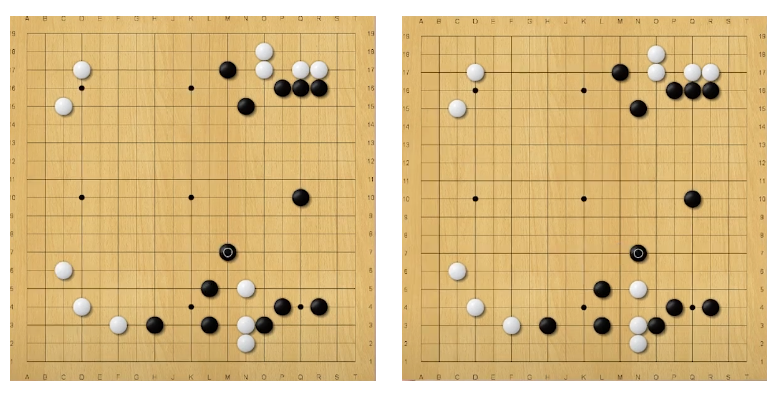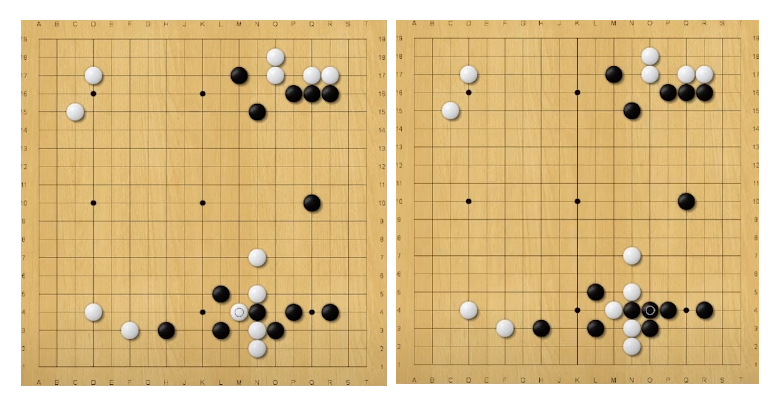The Strength of Stones
Theory-based Evaluation for Positional Judgment
Analyze the strength of stones to find the next move.
The reason why this concept is so emphasized, is that when you really break down and get to the essence of each of the other four concepts, what you will find is that they can all be explained by this one concept.
For every move, analyze the strength of all stones in order to determine what moves are big and what moves are small. Whether it's sacrifice, attack, direction, shape, or follow ups, we can rely on the analysis of the strength of stones to find the best move. And this applies to every move in every game.
• Moves near alive stones(strong stones) are small.
• Moves without the threat of a follow up are small.
• Moves near stones that aren't alive(weak stones) are big.
• Moves with the threat of a follow up are big.
When stones are not yet alive, they are weaker and we can expect to find follow up moves. Thus, moves in this are are big.
Example 1
Let's look at some examples, and along the way I'll show how this concept can be connected to the other basic concepts.
White has just played this knight's move to check black's group here on the bottom side. If you guessed that the jump from one of these two black stones was the right move, I think you have an understanding of the 5 concepts.
Direction of Play - Rule #1: Play from your weak groups. Since black's group here is checked on both sides and there is a 2nd line stone due to the Q3 kick, Black's two stones have little eye-space and is unstable. So, we want to move from these guys since they're not alive and consequently weak.
Perhaps you've noticed, that
play from your weak groups, is the same as Moves near weak stones are big. We play from the weak group not only because of good direction, but also to limit the opponent's options by defending against moves with follow ups .
We can also say push weak stones towards our strength, is the same as Moves near strong stones are small because we are effectively pushing weak stones towards our strength and making the opponent play moves that lack follow up.
Example 1: Options A & B
Now back to the example at hand, the one space jump from one of these stones would be the most orthodox response, but the problem here is there are two options for where to jump from. Here are the two options.

Using the two guidelines,
1) Moves near alive stones are small.
2) Moves without the threat of a follow up are small.
Which is the correct answer, A or B?
Correct Answer
How did you do, did you get it right?
The correct answer (A) is to jump from the right side. Perhaps you think that they're both one space jumps from the same group and so they're the same, but the nuance between these two moves effect the win rate by 6%. If you play A, white has about a 56% chance to win the game. But if you play B, white has about a 62% chance to win the game, according to katago on my machine.
Using the two key points of the strength of stones, we'll analyze why jumping from the stone on the right is better.
First of all, moves near alive stones are small.
Between the knight's move enclosure on the bottom left corner and the three stones in the bottom right quadrant, which of these two white groups is not alive? The enclosure on the left side is stable. It's alive. but the group on the right side has no eye shape and is a weak group. Therefore, instead of playing near the alive enclosure, playing near the weak group has more value.
Wrong Answer
So this move, is playing near the alive group. And, because you played near an alive group, you have no real follow up.
Follow Moves against Weak Group

For example: if white tenukis (plays elsewhere), black can knight's move or cap.

And even if white jumps again from the weak group, black can wedge to create these two cutting points.
Example 1 Recap
So although the two one space jumps were both just one space jumps from the same group, we can find the better move if we use this universal concept. I hope that now you see that jumping from the right side near the weak group aiming at the many follow up moves is the better move.

Once again, among the basic concepts of go, this one trumps them all by a landslide so let's look at another example to further consolidate this concept.
Example 2
Black to play.
What do you think of this move? In terms of direction of play, black is playing according to 'play from your weak stones'. But, it contradicts the concept of the strength of stones. If you can see how this move is contradicting the strength of stones, you have a pretty solid understanding of what moves are big or not.
Let's analyze the strength of the white group in the top left quadrant. It's pretty much invincible because there it's fully connected up, with plenty of eye shape. We can say that it's alive.
1) Moves near alive stones are small.
2) Moves without the threat of a follow up are small.
This move is playing towards strong, alive stones. Which means there's no immediate follow up threat. So ultimately, this follows
play from weak stones but is actually a small move.
Interestingly, we can even say that this move contradicts 'Push your opponent's weak stones towards your strong stones'.
Essentially, this large knight move is approaching white's strong group, and so from white's perspective, the opponent has just pushed himself into your strength for you! How generous. From this explanation, I think it is clear to see that black's large knight move here is actually bad direction, despite it looking reasonable at first glance.
Additionally, the theory behind Sacrifice stones covered in chapter 1 can be explained by this concept of big and small moves based on the strength of stones.
When we revisit this problem from the article on Sacrifice stones, we now see more clearly why white's marked stone was a mistake. White is going after stones that are near an alive group. So although the move presses black against his strong stones, black knows stones in that area will be small anyways. Thus, white won't get the flow that he is aiming for.
So what would be a better move?
Example 2: Answers
Option A
Because we don't want to approach white's thickness, this jump clearly commits to moving away from it. This move also helps increase the odds of the bottom side turning into a territory-moyo. And if not, this sort of position will aid in the fight when white jumps in to break it up.
Option B
If you don't consider the center group weak, playing like this is also valid, but anyways when you consider the concept of the strength of stones, either of these moves would be better than willingly pressing yourself against the opponent's strong group.
Recap
1) Moves near alive stones are small.
2) Moves without the threat of a follow up are small.
Conclusion
Don't let the simplicity of this concept fool you. Its power lies in its ability to distill the complexity of Go into a single, actionable principle. By focusing on the strength of stones and the potential for strong follow-up moves, you'll find yourself making better decisions, reading the board more effectively, and outmaneuvering your opponents.
Let's recap the journey we've taken:
- Determining sacrifice stones:
• Stones stuck to the opponent's alive stones.
• Stones that were played as kikashi.
- Attacking ideas:
• Know the joy of making your opponent play a painful move.
• Instead of surrounding territory with thickness, surround the enemy weak stones and create a ji-moyo with good direction of play and attention to the strength of stones.
- Direction of play:
• Play from your weak group.
• Push your opponent's stones towards your strong stones.
- Shape:
• Avoid empty triangles, and break your opponents shape by taking liberties and vital points to try and make them play the empty triangle.
• Don't split your own one space jump or knight's move, and take the push through if your opponent lets you push through a knight's move or one space jump.
- Strength of Stones:
• Moves near weak stones are big.
• Moves that have the threat of a follow up are big.
• Moves near alive stones are small.
• Moves without the threat of a follow up are small.
As you continue to practice and apply these concepts, you'll discover that they illuminate aspects of the game you never noticed before. Your Go intuition will evolve, becoming more nuanced, more strategic, and ultimately, more successful.
Now that you are up to speed with the fundamental concepts of go that many strong players use to evaluate positions, you can now play a bunch of games with a system for learning. Play and read variations with these concepts in mind, and then in the game review analyze the game based on these concepts. By training yourself to evaluate positions in this way, you will be able to internalize these concepts and when you apply them instinctively in your games.
Congratulations on reaching the end of this article! I hope that this article served to clarify the concepts of the strength of stones, and to serve as food for thought and inspiration for your next game.
-Hiro Nakae

